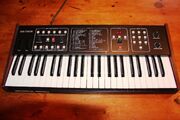
SCI Six Trak. Courtesy of synthmania.com
A polyphonic analog synth created by Sequential Circuits, and introduced in 1984. Sequential created the Six Trak during a period when rapid innovation was occurring in the synth industry, and Sequential was trying to create a successor to the Prophet 5, while at the same time trying to compete on cost and features with the Japanese manufacturers. In order to offer something unique, Sequential was moving in the direction of creating what we now refer to as arranger workstations, with extensive sequencing capabilities which most other manufacturers were not offering as an integrated capability at the time.
The Six Trak was six-voice polyphonic. The voice architecture was rather basic: one VCO with triangle, sawtooth and pulse waveforms, a low pass VCF, a VCA, an LFO with triangle and square waveforms, and three ADSR envelope generators, one dedicated to the VCA and one to VCF cutoff frequency; the third was routed to the VCO frequency. The LFO was routable to VCO frequency and pulse width, and filter cutoff frequency; as was the case with most of Sequential's later designs, moving the mod wheel added to the amount of LFO being routed to all destinations selected by the current patch. Patch memory consisted of 100 slots. Layering (referred to as "stacking" in the manual) was also available, and the performer could choose the number of voices to layer on a note, and assign a different patch to each layer. However, stacks were stored separately from patch memory, and only two memory slots were provided.
The most notable feature of the SIx Trak was its onboard sequencer, an advanced capability at the time. The sequencer allowed the performer to record and store two sequences, each consisting of six "tracks"; each track corresponded to a specific voice. Recording was real-time only; there was no step entry capability, and no quantizing was provided (the Multitrak, introduced the next year, added this feature). To record a sequence, the performer placed the sequencer into record mode and then selected the number of "tracks" to be used, which would be determined by the highest number of notes that the performer intended to play simultaneously during any point in the sequence. (For instance, if the performer planned to play three-note chords, three tracks needed to be selected.) After the initial recording, the performer could place the sequencer in an "overdub" mode, in which one or more additional tracks could be selected for record, which the already-recorded tracks played back in a loop. ("Punch-in" recording was not possible; fixing a mistake involved re-recording the whole track.) This process could be repeated until the performer was satisfied, or all of the tracks were used. Each track had its own patch selection and output level setting. During playback, the track select buttons could be used to mute or un-mute individual tracks. The voices for any tracks muted or not recorded were available for live playing during sequence playback. The Six Trak could store two sequences, with a total memory of 500 steps. An arpeggiator was also provided. Both the sequencer and the arpeggiator could be timed by either an internal clock, or by MIDI Clock from an external source.
The panel controls were minimal, consisting mainly of the buttons for patch selection and controlling the sequencer. Patch programming used a one-knob interface; part of the panel was given over to a silkscreened legend with the parameter numbers. (This was Sequential's first design to move significantly away from the knob-per-parameter paradigm.) However, all of the patch parameters were mapped to MIDI continuous controller numbers, a fortuitous choice which today allows a MIDI knob box to serve as a programmer, and most patch editor software can also interface with it. Performance controls consisted of a 49-key, non-velocity or aftertouch keyboard, a pitch wheel and a mod wheel, both of which were mounted on the panel above the keyboard. When Sequential introduced the Commodore 64 computer interface (described in the Multitrak article) in 1985, it provided the same benefits to the Six Trak, expanding sequence memory to 12,000 steps, managing patches, and interfacing with the other members of the "system" consisting of the Six Trak, the Multitrak, the MAX, and the TOM drum machine. The rear panel provided a monophonic audio output, a jack for a footswitch that could control certain sequencer functions, and MIDI in and out jacks (no thru jack).
The Six Trak remained in production until Sequential ceased doing business in 1987. Hints in the manuals indicate that Sequential may have intended to produce a lower-cost two-voice version, but this was apparently never prototyped.